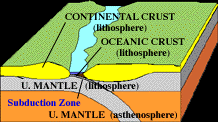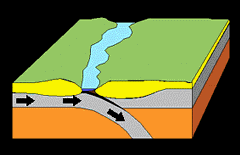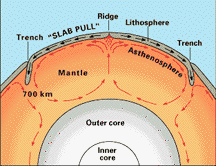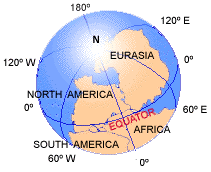WHEN CONTINENTS COLLIDE
 |
 |
 Mountains like
the Himalaya Range of Tibet resulted from the collision of the
continents. About 50 millions years ago moving tectonic plates brought
the continents of Asia and India into contact with one another. Such continental
collisions build spectacular mountain ranges.
Mountains like
the Himalaya Range of Tibet resulted from the collision of the
continents. About 50 millions years ago moving tectonic plates brought
the continents of Asia and India into contact with one another. Such continental
collisions build spectacular mountain ranges.
The Himalayas' emergence continues today, and similar processes produced other major mountain ranges in the geologic past.
Coal beds and plant fossils of West Virginia were preserved along deltas lying at sea level below the slopes of a mountain range created by continental collision 300,000,000 years ago-- at the suture where North America, Africa, and Europe slammed into each other.
See a relief map of this mountain range.
Although this ancient mountain range has been subsequently reduced to nothing by the forces of wind and rain, it's height and extent are believed to have equaled or exceeded the Himalayas of today.
This mountain-building process known as plate convergence works like this:
Earth's rigid lithosphere floats like a raft on the hot, ductile asthenosphere. Tectonic plates made up of rigid lithosphere are pushed laterally by circulating convection currents acting on the asthenosphere. Just what causes convection currents is not completely understood, but their circular movements are believed to be caused by earth's internal heat engine.
 |
Two rock types make up the lithosphere: oceanic crust and continental crust.
|
Spectacular mountains result from the collision of continental crust as tectonic plates collide, buckling and bunching continental crust along their impinging plate margins. This movement is slow-- only a few centimeters a year, but these forces are so powerful that some of the largest mountains in the the world were created by this process.
 300 million years ago such a mountain
range was created as Earth's two supercontinents assumed a collision
course with one another. Europe, Greenland, Siberia, North America, Kazakhstan,
and N.China comprised the supercontinent Laurasia, while Antarctica,
Africa, Arabia, India, Ceylon, Australia, New Zealand and South America
formed the supercontinent Gondwanaland. During this time Laurasia
and Gondwanaland were colliding to form the single giant supercontinent
Pangea.
300 million years ago such a mountain
range was created as Earth's two supercontinents assumed a collision
course with one another. Europe, Greenland, Siberia, North America, Kazakhstan,
and N.China comprised the supercontinent Laurasia, while Antarctica,
Africa, Arabia, India, Ceylon, Australia, New Zealand and South America
formed the supercontinent Gondwanaland. During this time Laurasia
and Gondwanaland were colliding to form the single giant supercontinent
Pangea.
The resultant mountain range that emerged ran generally east-west near 0 degrees latitude (equator) and may have been one of the greatest mountain ranges the world has seen, although subsequent continental movements and complete erosion have since obliterated all traces of it's highlands. Today, we know of it from remnants of it's exposed roots and from the vast sheets of sediments deposited in deltas along it's margins.
Known as the Late Carboniferous Period (also Pennsylvanian Period), this was a time during which the equator stretched from central Texas to Nova Scotia and from Great Britain to the Ukraine. The equator today is in the same place it has always been, but the position of the continents has greatly changed. Precipitation falling on the slopes of this great equatorial mountain range caused erosion and created rivers that carried sediments to it's adjacent coastal regions. Vast, low-lying deltas were created, supporting steamy tropical swamps which served as the nursery for earth's first forests. Several species of ancient ferns and trees developed and florished during this Age of Plants.
Thick beds of vegetation from these forests accumulated in stagnant waters that were very low in dissolved oxygen, preventing decay, creating repetitive sequences of thick peat beds subsequently preserved as beds of fossil carbon, hence the name Carboniferous Period. These beds were transformed over millions of years into important coal deposits which today comprise the great bituminous coalfields of Europe and Eastern North America.
It is here in this setting that the Carboniferous plant faunas lived and were preserved after burial to become Plant Fossils of West Virginia.
The Big Split
By 250 million years ago all the continental landmasses on earth had converged to form the single supercontinent Pangea. About 213 million years ago, during the Jurassic Period, Pangea began breaking apart and the continents began to reassemble themselves into new landmasses which comprise the continents we have today.
The expanse of the Atlantic Ocean as we know it today represents the
distance of relative plate separation resulting from the relentless forces
of continental drift since that time. The place of origin of this rift
is marked by the present-day Mid Atlantic Ridge, part of a 24,000
mile chain of underwater mountains that marks the zone along which the
earth splits and pulls apart as oceanic crust is created -- and is where
continental drift begins.
Our Living Planet
The world and life as we know it would not exist without continental drift and the ever-changing nature of our planet. Without continental drift, there would not be any mountains, or for that matter, any dry land at all. Over the course of geologic time the action of wind and waves would have reduced all dry land to sea level, and our planet would be one sloughish "Water World." In the absence of continental drift there would be no colliding tectonic plates to thrust up new dry land. Terrestrial creatures like ourselves would never have had the opportunity to evolve.
Our earth is truly a dynamic and ever-changing planet. The distribution of oceans and continents, mountains and valleys, deltas and deserts, are constantly changing. Climates are constantly changing, as are the ecosystems and the distribution and diversity of all life.
Far from being a fragile and delicate place, our planet is robust and dynamic and thrives on continual and substantial change, whether from collisions with asteroids, moving continents building mountains, or continual erosion. Mountains and oceans come and go. Animals like the dinosaurs and plant species like cordaites thrive in their day, then finally go extinct, making room for new and different species.
Although these changes are beyond the reach of human intervention, the challenge for mankind is to prudently manage the change we ourselves can cause so as to not change those superficial things that we deem necessary and desirable to our happiness and quality of life-- things like species we don't want to become extinct or unique scenery we want to set aside.
Of course we must be careful not to confuse this with preserving all animals and all scenery.
Constant change- not preservation- is the way of nature.